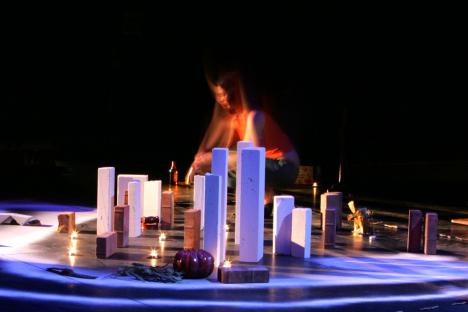City of Dreams: exquisite beauty and loss

City of Dreams (part of this year's PuSh Festival) provided an entertaining hour watching six performers use found or inexpensive objects with a recorded audio “soundscape” to create a map of Vancouver and depict its history. It is fitting that this work is presented at the Roundhouse Community Centre as it extends the Labyrinth and Rangoli activities of the Winter Solstice celebration held in the same venue into a complete piece of performance art.
The performance starts with a solo performer using twigs and tree roots to outline a city map to the sound of wind, then raindrops and birds as the other performers join in one by one. Cedar leaves are scattered to represent the land as it was before human settlement. Location of the Salish and Musqueam villages are marked with sand, small wooden pieces and a candle accompanied by the sound of chants and drums. European arrival and creation of Gastown is marked by snapping twigs, placement of wooden blocks and more candles to the sound of hammering and many birds.
The 1886 fire that destroyed Gastown is represented by the replacing the wooden blocks with sand to the sound of roaring flames and then an archival recording of one of the survivors recalling how she and her family were saved while others were less fortunate. As the town is rebuilt and expands, the cedar leaves are removed and replaced by wooden blocks, dominos, more candles, bricks and various other symbolic objects such as a tea set in the west end, and liqueur glasses in Kerrisdale. The soundscape provides archival recodings of a man about the arrival of the first train, the first car, the first cash register and the Chinatown riots before we hear the sounds of church bells, a somber marching band and horses. Eventually the objects that represented the original native settlements are removed and we hear a some jazz with a radio ad from the second world war exhorting the populace to purchase stamps to support the war effort.
As more bricks and square vases are placed around the map and a large toy airplane is placed to represent the airport, we hear a humorous except from a Jack Benny visit to Vancouver, pre game announcements from a Canucks game, Expo 86 promotions and finally Diana Krall singing the Look of Love. Water glasses are placed around the perimeter and filled with water. Fog is released that makes the illusion of the city real particularly for those seated in the rear, upper seats. The performers who have been working silently until this point, now speak brief phrases that encapsulate their favourite memories of the city e.g. cherry blossoms in the spring. The show concludes with the performers handing out the glasses of water and inviting the audience down to the stage to inspect their creation.
In the post show talk led by David Pay, the UK based director, Peter Reder, revealed that his process for creating the Vancouver show is like those he has done in other cities such as Singapore, Brisbane or Melbourne. It involves a combination of research at libraries, museums and archives together with the public memories from the local cast members. He is interested that these cities have grown mostly over a much shorter timespan than the 1000 years of many European cities and much of it is documented with recordings. Political views and commentary is minimized so that each viewer can use the work as a background to whatever perspective they wish. The essential intent of the work is to create something with exquisite beauty but also reflect on what has been lost in getting to the present. One of the cast members noted that their involvement before the show was one week to collect audio samples for the soundscape, one week to collect the various materials for the map and a few days to rehearse. Another noted that the map uses a fisheye lens perspective focussed on the Gastown - Downtown area in part because that is where much the historical action happens. The soundscape was designed by Tom Wallace with the assistance of the others such as Barry Truax (also of the Terminal City Soundscape PUSH production) and the cast.
The show has an accompanying contemporary art exhibition called Counter Mapping that is open during the day free to the public in the large hall beside the theatre entrance. Curator Caleb Johnston provides a nice booklet containing descriptions of the twenty or so installation pieces including many video installations. One of the highlights is Jamie Hilder’s video of a fake Downtown Ambassador providing tourist misinformation with the exhibit of his mock uniform. This was quite amusing at times and tense when he is confronted by the real DA’s. Another is an amusing video of people on the Stanley Park seawall including a man running backwards while barefoot. A pair of interesting pieces show various journeys throughout the area with their movements recorded by GPS line maps and a soundscape of recordings matched to slides of various iconic locations. T shirt fans might enjoy a selection that depicts images from the various city neighbourhoods. It might require more time to enjoy the many installation pieces in this art exhibit than to watch the City of Dreams performance.



